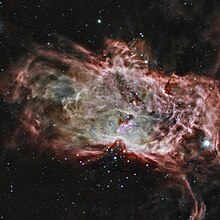불꽃 성운
Flame Nebula| 방출성운 | |
|---|---|
 | |
| 관측 데이터: J2000.0 epoch | |
| 우측 상승 | 05h 41m 54s |
| 탈위임 | −01° 51′ 0.0″ |
| 거리 | 1350[1] ly (415 pc) |
| 겉보기 크기 (V) | 10[2] |
| 외관 치수(V) | 30x30' |
| 별자리 | 오리온 |
| 물리적 특성 | |
| 반지름 | 6리 |
| 지정 | NGC 2024 및 샤플리스 277 |
NGC 2024와 Sh2-277로 지정된 불꽃 성운은 오리온자리에 있는 방출 성운이다.약 900~1500광년 떨어져 있다.
오리온 허리띠에서 가장 동쪽에 있는 밝은 별 알니탁(Alnitak, ζ Ori)은 불꽃에 에너지 넘치는 자외선을 비추고, 이것은 그곳에 살고 있는 수소 가스의 거대한 구름으로부터 전자를 떨어뜨린다.대부분의 빛은 전자와 이온화된 수소가 재결합할 때 발생한다.추가적인 암흑가스와 먼지가 성운의 밝은 부분 앞에 놓여 있고 이것이 그 빛나는 가스 중심에 나타나는 암흑망을 일으키는 원인이 된다.불꽃 성운은 유명한 말머리 성운을 포함하는 항성형식 지역인 오리온 분자 구름 복합체의 일부다.
불꽃 성운의 중심에는 새로 형성된 별들의 군집이 있으며,[3] 이 중 86%가 항성 원반을 가지고 있다.[4]찬드라 엑스레이 관측소의[5][6] X-ray 관측 결과, 약 800개의 별 중 수백 개의 젊은 별들이 관측되고 있다.[7]X선과 적외선 사진은 가장 어린 별들이 성단의 중심 근처에 집중되어 있음을 나타낸다.[8][9]
갤러리
참고 항목
참조
- ^ Meyer, M. R.; et al. (2008). "Star Formation in NGC 2023, NGC 2024, and Southern L1630". In Reipurth, B. (ed.). Handbook of Star Forming Regions, Volume II: The Southern Sky ASP Monograph Publications. Vol. 5. p. 43. Bibcode:2008hsf1.book..662M. ISBN 978-1-58381-670-7.
- ^ "Is the Flame nebula easier to see than the Orion nebula?". stargazerslounge.com. Retrieved 2018-03-24.
- ^ Haisch, K. E. Jr.; Lada, E. A.; Lada, C. J. (2000). "A Near-Infrared L-Band Survey of the Young Embedded Cluster NGC 2024". Astronomical Journal. 120 (2): 1396–1409. arXiv:astro-ph/0006219. Bibcode:2000AJ....120.1396H. doi:10.1086/301521.
- ^ Haisch, K. E. Jr.; et al. (2001). "A Mid-Infrared Study of the Young Stellar Population in the NGC 2024 Cluster". Astronomical Journal. 121 (3): 1512–1521. arXiv:astro-ph/0012482. Bibcode:2001AJ....121.1512H. doi:10.1086/319397.
- ^ Skinner, S.; Gagné, M.; Belzer, E. (2003). "A Deep Chandra X-Ray Observation of the Embedded Young Cluster in NGC 2024". Astrophysical Journal. 598 (1): 375–391. arXiv:astro-ph/0306566. Bibcode:2003ApJ...598..375S. doi:10.1086/378085.
- ^ Broos, P. S.; et al. (2013). "Identifying Young Stars in Massive Star-forming Regions for the MYStIX Project". Astrophysical Journal. 209 (2): 32. arXiv:1309.4500. Bibcode:2013ApJS..209...32B. doi:10.1088/0067-0049/209/2/32.
- ^ Kuhn, M. A.; Getman, K. V.; Feigelson, E. D. (2015). "The Spatial Structure of Young Stellar Clusters. II. Total Young Stellar Populations". Astrophysical Journal. 802 (1): 60. arXiv:1501.05300. Bibcode:2015ApJ...802...60K. doi:10.1088/0004-637X/802/1/60.
- ^ Getman, K. V.; Feigelson, E. D.; Kuhn, M. A. (2014). "Core-Halo Age Gradients and Star Formation in the Orion Nebula and NGC 2024 Young Stellar Clusters". Astrophysical Journal. 787 (2): 109. arXiv:1403.2742. Bibcode:2014ApJ...787..109G. doi:10.1088/0004-637X/787/2/109.
- ^ Nemiroff, R.; Bonnell, J., eds. (10 May 2014). "Inside the Flame Nebula". Astronomy Picture of the Day. NASA. Retrieved February 14, 2015.
외부 링크
| 위키미디어 커먼즈에는 불꽃 성운과 관련된 미디어가 있다. |
- NGC 2024년 천체사진술
- "NGC 2024". SIMBAD. Centre de données astronomiques de Strasbourg.
- Nemiroff, R.; Bonnell, J., eds. (13 July 1999). "The Flame Nebula in Infrared". Astronomy Picture of the Day. NASA.
- 위키스키의 불꽃 성운: DSS2, SDSS, GALEX, IRAS, 수소 α, X선, 아스트로포토, 스카이맵, 기사 및 이미지









